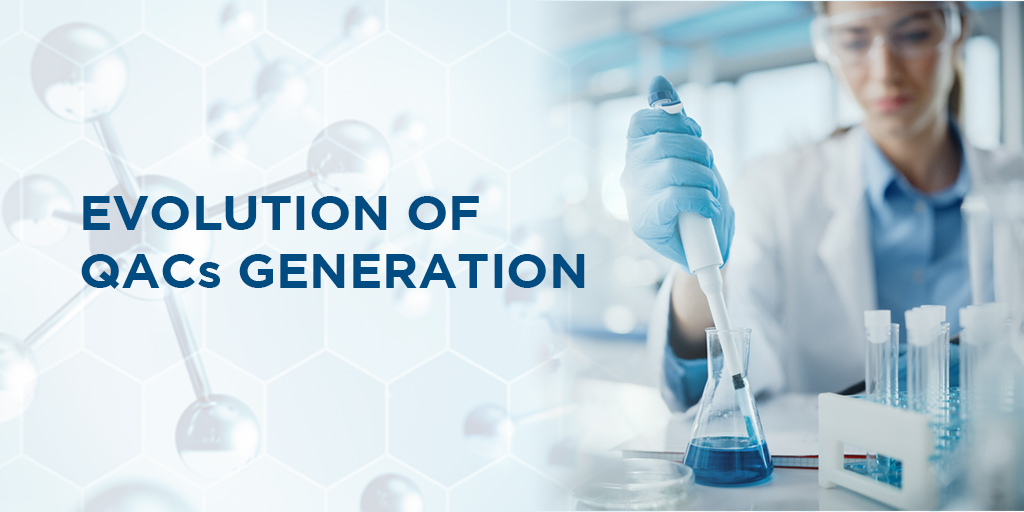
Evolution of QACs generation
Quaternary ammonium compounds (QACs) have evolved a lot as a biocidal agent & among the most commonly used disinfectants to kill dangerous pathogens. Many commercial cleaning products marketed as antibacterial products & alcohol-free hand sanitisers contain QACs as active ingredients.
The biocidal activity of QACs is well known, not just because of its efficacy but also due to many other factors in which they are able to perform their tasks with ease. They provide significant public health benefits by controlling bacteria, viruses, and other pathogens that cause infections such as colds, flu, and COVID.
Based on toxicology and efficacy data- QACs are registered as antimicrobials by regulatory agencies around the world.
Classification of Quaternary ammonium compounds
Increasing development in biocidal chemistries has given a rise to many generations of QAC’s and are still getting better & better. Quaternary ammonium compounds are classified as:
1st Generation of quaternary ammonium compounds- Alkyl Dimethyl Benzyl Ammonium Chlorides (ADBAC). First generation quats have the lowest relative biocidal activity. Benzalkonium chloride is one type of ADBAC quat.
2nd Generation of quaternary ammonium compounds-The substitution of the aromatic ring hydrogen with methyl or ethyl groups resulted in this second generation quat. For example, Alkyl Dimethyl Ethyl Benzyl Ammonium Chloride (ADEBAC). However, this type of quat is not marked by itself but in combination with ADBAC.
3rd Generation of quaternary ammonium compounds- Dual Quats, mixture of the 1st & 2nd generation (example: Equal mixture of ADBAC & Alkyl Dimethyl Ethyl Benzyl Ammonium Chloride ADEBAC) This mixture of two specific quats resulted in a “Dual Quat” offering increased biocidal activity over the ADBAC quat alone.
4th Generation of quaternary ammonium compounds- Twin or Dual Chain Quats. Dialkyldimethyl Ammonium Chloride or DDAC quat. Fourth generation quats are superior in germicidal performance and have an increased tolerance to organic loads and water hardness.
5th Generation of quaternary ammonium compounds - Mixture of the fourth generation with the first generation, that is, Didecyl Dimethyl Ammonium Chloride + Alkyl Dimethyl Ammonium Chloride produces fifth generation QAC. It has a greater germicidal performance in harsh conditions and is safe to use. It gives both cleaning & disinfection activity. It works efficiently in presence of organic matter & in presence of hard water. Compatible with most of the surfaces with least side effect profile and least residue built-up, Fifth generation QAC are a most trusted compound which is EN & EPA certified and also recommended against COVID.
6th Generation of quaternary ammonium compounds- Polymeric QACs have recently shown to have potent antibacterial and antiviral properties with limited toxicity; making them promising for medical implants, catheters, food processing, and surface sanitizing.
7th Generation of quaternary ammonium compounds- Bis-QACs with polymeric QACs, the most current QAC generation has led to continuous increase in efficacy while reducing toxicity and cost.
The latest generations of QACs (6th & 7th) are better than the previous generations of QACs; in terms of better tolerance on skin, less toxic, environment friendly, require in very less concentrations and less contact time, work better in synergies and ultimately better in efficacy and action spectrum against various pathogens including Spores, Mycobacteria and ESKAPE. Also, they are better in dealing with bioburden, biofilms and resistance development.
Bioguard products with the latest generation QACs with the power of BIOCHEM® -patented compound for high-performance cleaning & disinfection makes it more effective than alternative ‘local brands’ is now available in the market.
Highlighting the benefits of QACs- Bioguard associated with the renowned microbiologist Dr. Tim Sandle, where he discusses the advantages of quaternary ammonium compounds for disinfection and infection control.
Click here to know more- https://www.clinicalservicesjournal.com/story/37627/advantages-of-quaternary-ammonium-compounds
Benefits of Bioguard Products:
- Trusted & Proven – Used by healthcare professionals across the UK, Europe, GCC & India in high-risk environments. Independently tested to the highest European and British standards against high-risk organisms.
- Powerful – Microbiological efficacy means our products are effective against a wide variety of organisms such as Clostridium Difficile (spores & bacteria), Hepatitis, Tuberculosis, Norwalk virus, HIV, MRSA, and Avian Flu & ESKAPE Pathogens under 30 Seconds*.
- Safe – Products are non-hazardous and non-toxic and have been MEA tested to ensure they are safe and will not harm users.
- Multi-surface – Usable on virtually all surfaces (including fabrics and furnishings), so can decontaminate whole environments without causing degradation to surfaces.
- Alcohol free – Zero alcohol content (with no compromise on performance) ensures product is gentle on skin and also meets certain users’ religious observances.
- Patented Compound - All products are powered by Biochem, a unique compound for high performance cleaning & disinfection; effective against bacteria, viruses & spores including Covid-19.
- Manufacturing Excellence - Having full control over the entire research & development manufacturing processes ensures we produce the highest quality products made to our exacting quality standards as well as the latest ISO & GMP registration standards.
Here’s what people are saying about our product:
“Bioguard hand & body foaming cleanser is really effective for cleaning and disinfecting patients who are bed-bound” - Nursing-home Professional
“Bioguard hand & body foaming cleanser is more effective than alternate surgical gels and is less of a health and safety risk” - NHS Nurse
“A much better and more economical alternative to hand gels” - GP Practice Manager
Conclusion - QAC-based formulations continue to evolve and provide broad spectrum efficacy, short contact times, extensive shelf life and stability profile, low odor, safety, and a wide effective pH range. They serve as the top infection prevention solution for surface treatment in the healthcare environment.
Get in touch with us to learn more about our products and how they can make your healthcare facility safer!


